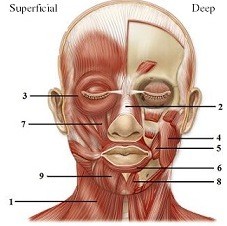 This figure shows the muscles of facial expression. What muscle does number 2 indicate?
This figure shows the muscles of facial expression. What muscle does number 2 indicate?
A. Platysma
B. Epicranius
C. Nasalis
D. Procerus
E. Orbicularis oculi
Answer: C
You might also like to view...
After a severe burn, new skin may grow outward from the hair follicles. New growth begins here because
A. a person has many hair follicles. B. the hair follicles are very resistant to fire and heat. C. the hair follicles are located in the subcutaneous layer. D. a hair follicle contains stem cells in the bulb region.
Phosphate transfer is used for
A. immediate ATP needs and is dependent on oxygen. B. immediate ATP needs and is not dependent on oxygen. C. long term ATP needs and is dependent on oxygen. D. long term ATP needs and is not dependent on the presence of oxygen.
Lymphocytes can be found in:
a. lymph nodes b. the thymus c. the liver d. all of the above
In the regulation of body processes, the effects or hormones last longer than those of neurotransmitters.
Answer the following statement true (T) or false (F)